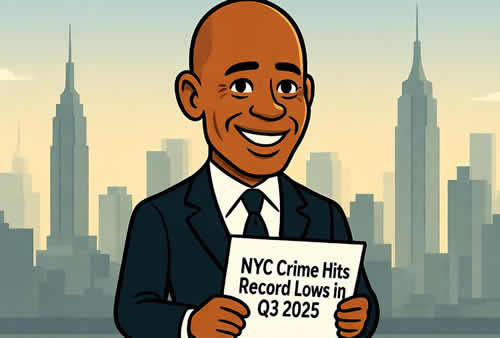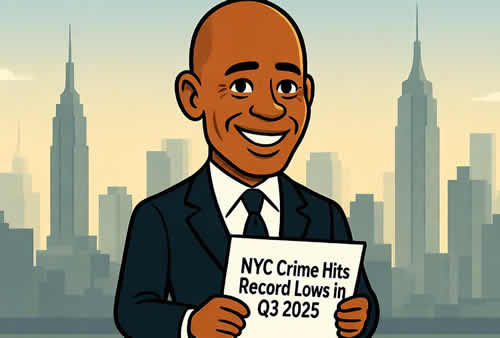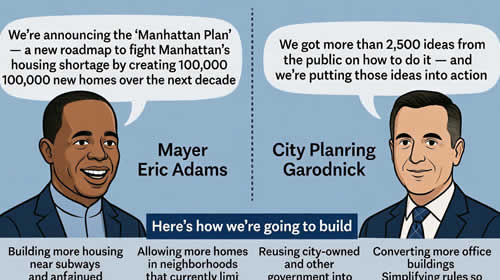
Mayor Eric Adams and NYPD Commissioner Jessica S. Tisch announced third-quarter crime stats showing seven consecutive quarters of declining major crime since January 2024, with six of seven index categories down. Shooting incidents fell 15.6% in Q3 (-29.7% in September) and victims hit record lows, aided by 4,100 illegal guns seized this year and nearly 24,000 since the administration began. Transit crime reached all-time lows (excluding pandemic years) and retail theft dropped 19% in Q3 and 13% year-to-date, driven by data-focused “summer zones,” visible foot posts, and coordinated enforcement. Boroughs citywide saw reductions, with the Bronx reversing an earlier uptick; murders are near historic lows. While highlighting safety gains and improved rider confidence, officials warned that proposed federal cuts to NYPD counter-terrorism funding could undermine future readiness.
Mayor Adams and NYPD Commissioner Jessica S. Tisch Brief the Media on Third Quarter Crime Stats, Record Low Shooting Incidents, and Shooting Victims for First Nine Months of the Year
Mayor Eric Adams: Thank you so much, good afternoon. When I ran for office, I was clear on one message. Public safety is a prerequisite to our prosperity. And I threw everything at public safety and ensuring that our citizens could be safe. Probably unlike any other mayor, I spent so many days on the streets of shootings, of homicides, of victims, of individuals being shoved to our subway tracks.
I’ve been in hospitals, funerals, speaking with parents, hearing and feeling the pain that they experience when they are the victims of any form of criminal action. And numbers don’t lie, what we have done is clear.
We lived up to our commitment, and I say it over and over again, we can’t go backwards. We can’t go back to the days of the early 80s when I was a rookie police officer, and we can’t go backwards to 2021. Guns were known to be ordinary tools that were used on our streets to permit crime.
Our 2025 third quarter crime data shows that our public safety system is working. We have gone to work to sweep out crime and illegal activities from our neighborhoods. So if we were to start with the top line, because of what this team has done, not only the commissioner and Chief LiPetri, but also those who are in the front rows. On our subway system and housing, our chief of the Department, our entire team were out there doing the job every day, as well as the men and women who are adorned in the blue uniform and wear that shield on their chest.
We have finished our seven consecutive quarter of crime reduction, seven consecutive quarters. And when you think about it and say it simply, since January 2024, for almost two straight years, crime has consistently declined each and every quarter. Major crime for the third quarter was 3.1 percent equated to over 1,000 fewer victims. And that’s more than 1,000 real people who were no longer the victims of serious crime. And more specifically, six of the seven major crimes were also down for this quarter. Including declines in homicides, robberies, felony assaults, burglaries, grand larcenies, and auto theft.
Major crime in our subway system and our public housing developments were also down for the third quarter of the year, chief of Housing and chief of Transit, a job well done. We cannot thank you enough for what you have accomplished. And those have been areas, particularly housing, where public safety has eluded us for decades. And although you hear about some of the high profile incidents, overall the residents of NYCHA are safer and the residents of our subway system.
When you take out the two years of the COVID, two years when no one was on the subway, you’ll see how these numbers are significant. We set records in our transit system. We had the safest summer in recorded history in our subways when you exclude the pandemic years.
In the third quarter, July, August, and September, index crime was a record low in our subway system except for ‘20 and ‘21. Shooting incidents were also, once again, at record lows for the first nine months of the year. No caveats, no asterisks, plain and simple, the lowest. [Inaudible] at record lows in our city history has continued to show that we’re doing the right thing.
Shooting incidents were down 29.7 percent for September and 15.6 percent for the third quarter of 2025. For the first nine months of the year, shooting victims were also at record lows, tying the previous record set in 2018. Shooting victims were down 32.5 percent for September and 11.3 percent for the quarter.
Shootings are down at a staggering 54 percent, when you compare New York City year to day shootings to the same period immediately before I took office. Those are the dividends paid for more than 4,100 illegal guns removed off our streets. 4,100 illegal guns and the almost 24,000 guns removed since the start of our administration. And that 4,100 number was for this year alone.
This is 24,000, 24,000 weapons that no longer threaten the safety of our neighbors, our families, and our children. More specifically, for September, major crime was down 2.8 percent. It was driven by a decrease in six of the seven major crime categories. That includes double digit percentage declines in homicides, rape, and auto theft, as well as declines in robbery, felony assaults, and burglary.
Retail theft, which you are watching across the country, is taking off. And so we should think about that when individuals want to stop enforcing retail theft, what impacts the financial stability of our city. Retail theft in this city and hate crimes are both continuing their decline for month, quarter, and year to date. This reduction in crime is no accident.
It’s the product of our administration priority to take on crime and quality of life issues. While these numbers show real progress, we know there’s more to do. And we’re not resting until every New Yorker is not only safe, but feels safe in their home, in our subways, and on our sidewalks. We have been clear in this administration, we will not tolerate a feeling of anything goes in our streets. And that includes those who want to carry out quality of life conditions.
We’re going to ensure that we enforce them as long as I’m the mayor of this city. We’re making New York City the best place to raise children and families. Because of our steadfast focus on public safety, the deep bench of leaders we’ve put in place here at police headquarters. And the hard work of the brave men and women of the NYPD, New York City remains the safest big city in America. And a clear indication was that we just had UNGA, UN General Assembly week. And we had Jewish High Holidays, the New Years, and you saw the proper deployment to deal with the dignitaries who were here, as well as ensure that those who wanted to worship were able to worship in safety.
We’re going to continue to do the job that New Yorkers expect from us. I want to turn it over to the commissioner, Commissioner Jessica Tisch.
Police Commissioner Jessica Tisch: Thank you, sir. Good afternoon. It is with deep appreciation for Mayor Eric Adams and immense pride in the women and men of the NYPD that I’m here to report on some historic, record breaking crime reductions achieved by your NYPD cops in the third quarter of this year. Months of July, August, and September, including the fewest shooting incidents for the first nine months of any year, and for any third quarter in recorded history.
Tied for the fewest shooting victims ever for the year, and the second fewest by one for the last quarter. Seven straight quarters of declining major crime under Mayor Adams going back to January 2024. The safest third quarter ever on our subways with all time low major crime numbers for each of the months of July, August, and September, excluding the COVID years. And murders equaled their second lowest level ever for both the third quarter and the year to date.
So let’s get into it and let’s start with shootings. In the first nine months of this year, citywide shooting incidents are down more than 20 percent, their lowest levels ever, shattering the previous record low set in 2018 by 20 fewer incidents. And they are down nearly 16 percent for the quarter, making it the fewest shootings in any third quarter in recorded history.
Shooting victims are also down 19 percent for this year, tied for their lowest levels ever. And they were down more than 11 percent last quarter, the second best third quarter in recorded history. We always hear about how shootings spike in the summer months, but your NYPD cops did not just slow that trend, they reversed it.
Shooting incidents fell by double digits in four out of our five boroughs last quarter, led by a 26 percent reduction in the Bronx, a 20 percent reduction on Staten Island, a nearly 19 percent drop in Manhattan, and an almost 18 percent reduction in Queens.
In Brooklyn, shootings were up less than 3 percent for the third quarter, which represents two more shooting incidents in that borough from a year ago. But it is still the second best quarter for Brooklyn shootings in recorded history. And to be very clear, over the past nine months, Brooklyn has seen the lowest number of shootings ever recorded.
For the year, the decline in shooting incidents is led by Staten Island at more than 38 percent, Manhattan at over 34 percent, followed by Queens at 22 percent, the Bronx at 20 percent, and Brooklyn at more than 12 percent. And this is not a coincidence. It is the direct result of an unprecedented, precise, data-driven deployment of thousands of officers.
We took cops out of desk jobs and put them on high visibility foot posts where and when they were needed most. And we told them to get the guns and to go after the gangs, and they did that in unprecedented fashion. I encourage all New Yorkers to join me in expressing their deep appreciation for the men and women of the NYPD for their noble, selfless, and historic work this summer.
The centerpiece of our strategy over the last quarter has been our summer zones. Up to 2,300 cops were sent to work in 72 summer zones across nearly 60 communities last May. The largest deployment of its kind in NYPD history. But this strategy wasn’t just about size. It was about planned precision, and it worked.
Over the past 19 weeks in our summer zones, shooting incidents fell more than 47 percent during deployment, with shooting victims down 44 percent. This includes a 77 percent reduction in Manhattan North, a 46 percent reduction in Brooklyn North, and a 40 percent reduction in shootings in the Bronx. I want to be clear, the communities where we’re seeing the deepest reductions in violent crime are the same communities that have historically been plagued by the most gun violence.
We saw crime reductions in every single borough during deployment, with overall crime in our summer zones down more than 18 percent, felony assaults down 25 percent, robberies down 23 percent, murders down 18 percent, auto theft down 15 percent, grand larceny down 12 percent, and burglary down nearly 1 percent.
This is what happens when we’re not only working hard, but we are working smart. We know that this zone plan is effective, and we know why. It is a data-driven, scalpel approach to fighting crime and disorder. That strategy is going to continue into the fall, and you’ll hear more about the summer zones from the architect of that strategy, Chief LiPetri, in a moment.
Now let me give you the overall crime picture. For both the third quarter and year to date, major crime is down in our precincts, on our subways, and in our housing developments. For the year to date, overall crime is down about 4 percent citywide, and fell more than 3 percent last quarter, making this the seventh straight quarter of declining crime under Mayor Adams, going back to January of last year. And for the month of September, major crime was lower in every one of our eight patrol boroughs.
Of note, we had significant crime reductions in Queens of nearly 7.5 percent for the quarter, and more than 9 percent for the year. And Manhattan, down more than 5 percent for the quarter, and over 4 percent for the year. And in the past three months, we reversed an upward trend that we were seeing in the Bronx, going from a 6.2 percent crime increase in the second quarter to a 3.4 percent decrease in the third quarter.
Given that the past three months are historically when our city sees the most crime and violence at any time during the year, I want to commend all of the Bronx cops who refused to accept the narrative that their borough was an outlier when it came to public safety.
Where they did see stubborn pockets of crime, they executed our plan to address it. Looking at the seven major crime categories, citywide murders are down nearly 18 percent for both the year and for the quarter, bringing them to their second lowest level ever for both time frames. And these aren’t just percentages, they are lives saved.
So far this year, there have been 52 fewer people killed in New York City compared to 2024. Burglaries in the third quarter were down to their second lowest level in recorded history, dropping more than 9 percent, and they are down nearly 4 percent for the year.
Citywide robberies are down nearly 10 percent year to date, and more than 5 percent for the quarter. That means 1,200 fewer incidents than in 2024, reversing an upward trend that we saw through the first nine months of last year. Grand larcenies fell by more than 4 percent for the year, and we’re down 0.5 percent for the quarter, extending the declines we’ve seen in this crime for the last three years in a row.
We’re seeing similar multi-year declines in auto theft. After a significant increase during and immediately after the pandemic, we are now down by more than 4 percent for both the year and the third quarter.
Felony assault, a crime that is mainly driven by domestic violence and attacks on our officers, is about 1 percent lower for the year and down nearly 4 percent for the quarter. And back in July, when we presented the second quarter crime stats, we said that rape was the one index crime that had increased up 21 percent through June. And we explained that the rise was largely due to a change in state law that went into effect in September 2024, which rightfully broadened the legal definition of rape to better capture the full range of these crimes.
Now that we’re past the one year mark of that change, we finally have a clear year over year comparison. And the numbers do show progress. For September of this year compared to last, rape was down more than 13 percent, and this is the first time in over 12 months that we are looking at the same universe of survivors.
And the tide is also turning on our subways. Outside of the COVID years, we just had the safest third quarter ever in transit with major crime falling by nearly 14 percent. Each of the past three individual months, July, August, and September, was the safest in recorded history for major crime. And year to date, crime in our subways is down more than 4 percent to its lowest levels in 15 years, excluding the pandemic years.
For this year, robberies in transit are down to their lowest levels ever, and shooting incidents are down a remarkable 67 percent. Overall, crime in our subways is nearly 12 percent below pre-pandemic levels, with robbery down more than 24 percent, and felony theft down nearly 27 percent.
These results don’t just make the transit system safer, they make people feel safer too. A recent poll conducted by the MTA showed that nearly seven out of ten New York City subway riders felt safe while using the system, an increase of 12 percent from the beginning of this year. Why? Because people are seeing more cops on the trains and on the platforms where we know that the vast majority of transit crime occurs.
The sentiment is shifting, and it’s not just about a visible police presence. Over the past ten years, the transit rules against taking up multiple seats, laying outstretched, smoking, drinking alcohol, etc., were not consistently enforced. This increased the perception of an unsafe system, and it needed to change.
So this year, we made that change. Our cops will no longer walk by someone who is violating the law and disrupting other passengers, they will correct the condition. And I want to be clear, this is about restoring a sense of safety and order in the system. It is also a response to New Yorkers telling us that unchecked disorder makes them feel less safe on the trains. That’s why we’re also matching our enforcement with services.
Through the mayor’s PATH program launched last year, the NYPD has partnered with city agencies, local nurses, clinicians, service providers, and others to provide services such as shelter, meals, medical care, and mental health support. This is how we deliver a safer, more accessible system for all.
Looking ahead, I want to highlight an issue that has taken on increased importance in neighborhoods across our city, and that is retail theft. The numbers here are encouraging. In the third quarter, retail theft dropped by nearly 19 percent citywide, bringing us 13 percent lower for the year compared to 2024. And this didn’t happen by accident. It is a true indicator of what an effective, comprehensive crime fighting plan can really do.
For too long, shoplifting was a leading sign of disorder and lawlessness on our streets to the point where everyday goods behind lock and key has become the norm. Since most retail theft is classified as a misdemeanor though, it wasn’t given the same attention as more serious violent crimes were. But tell that to the small businesses who are constantly victimized by thieves. Tell that to the local shop owners who are unable to make their rent and forced to close in the face of crushing shoplifting losses. It’s devastating to them and it hurts our communities and the NYPD has said no more through a multifaceted, precise, data driven approach.
This year, every precinct in the city has designed and implemented a retail theft plan, which puts officers on foot posts in high propensity locations during the specific hours when most retail theft occurs. And we began seriously investigating these crimes as well. Establishing patterns, identifying recidivists, tracking perps, and closing cases.
This includes closer coordination between patrol cops, squad detectives, and transit officers. Since we know many shoplifters attempt to flee into our subways. Finally, retail theft became a focal point of our weekly CompStat meetings, where local commanders provide our executive staff with regular updates on what’s working and discuss solutions to what isn’t.
The results are clear. Our officers made nearly 6,600 shoplifting arrests last quarter alone. A 30 percent increase from pre-pandemic levels and nearly 21,300 arrests citywide so far this year, which is 40 percent more than in 2019. So it is no wonder that in 2025, retail theft is down in four of our five boroughs.
This work restores order in our neighborhoods. It restores the confidence of our local businesses and it sends a direct, unambiguous message. Shoplifters, regardless of the amount they steal, will be investigated, identified, and arrested. Because accountability matters here.
In a moment, our Chief of Crime Control Strategies, Mike LiPetri, will break down these numbers even further. But I want to take this opportunity to thank the women and men of the NYPD. Every piece of data we’re presenting today is a reflection of their work.
When we talk about record setting crime reductions, we’re talking about the cops. These gains have been achieved on their backs. Long, hot nights of grueling foot posts, risking their own lives to get guns off the street, and an uncommon instinct to run toward the danger when everyone else runs away. These results are also a reflection of the steady leadership and forward leaning strategies developed by our chiefs. Among them, of course, our Chief of Department, John Chell, our Chief of Crime Control Strategies, Mike LiPetri, our Chief of Patrol, Phil Rivera, our Chief of Transit, Joe Gulotta, our Chief of Housing, Charles McEvoy, and our Chief of Detectives, Joe Kenney.
New Yorkers should know that they are served by the most extraordinarily talented group of police leaders that I have seen in my 18 year career. No one does it better, and it is truly the greatest privilege of my lifetime to lead them. And of course, none of this would be possible without the leadership of Mayor Adams, who has made public safety the bedrock of his long service to the city.
Under his watch, we’ve invested in the tools of tomorrow from drones that expand our reach to new facilities, like the 4-0 station house and the brand new 116 precinct that strengthen our foundation. He has given us the people we need, setting us on a pace this year to hire more officers than at any time in the past 40 years. He has quite literally backed the blue.
His vision has turned promises into progress, and his partnership has made New York safer, stronger, and more secure. And all these results are a testament to his leadership. So that was some very good news, but now I have to comment on some profoundly bad news.
The federal government’s decision to slash counter-terrorism funding for the NYPD from 90 million down to nearly 10 million is a betrayal of this city. I want to be very direct about this. If these cuts go through as planned, it will represent a devastating blow to our counter-terrorism and intelligence programs in New York City. The impact of these cuts won’t be felt immediately. New York City will not be a less safe place tomorrow as a result of all of this.
But it will absolutely be a less safe place six months from now. Let me be clear, these funds are the backbone of the NYPD’s counter-terrorism programs. They pay for our highly trained bomb squad technicians, our officers with heavy weapons who guard our subways in major events, the critical response teams who do counter-terrorism patrols at our houses of worship and other sensitive locations, our radiation detection capabilities, the intelligence analysts who uncover plots before they become attacks, our camera systems that enable us to monitor conditions in real time, and the training that prepares us for active shooter attacks.
Counter-terrorism funding cannot be a political issue. It cannot rise and fall based on partisan whims. To strip this funding away from the number one terrorist target in the world is a profound mistake. The cold, hard truth is that since 9/11, New York City has faced more than 70 terrorism plots and ideologically driven acts of violence. And with the support of these critical resources, the women and men of the NYPD have kept our city safe.
Cutting these resources now in a time of global conflict and surging threats puts lives at risk and will make our city meaningfully less safe. To be blunt, this is the difference between a city that prevents the next attack and a city left exposed to it. And I will not stop pressing this issue until the federal government restores the funding and ensures that we continue to have the resources that we need to keep you all safe. Now, I will turn it over to our Chief of Crime Control Strategies, Michael LiPetri.
Michael LiPetri, Chief of Crime Control Strategies, Police Department: Good afternoon. So as the commissioner said, I’m going to speak specifically about the Summer Violence Plan of 2025, which started on May 5th and it ended on September 14th. We identified 72 summer zones across the city for targeted deployment at specific times. 40 precincts, 10 transit districts, and 8 public service areas. The zones were based off of historical data, high volume, violent street crime prone locations.
We used historical intelligence and data analytics to determine deployment, with of course, relentless follow up and precision. Collaborative policing and investigations between all units in the department. Our Gun Violence Suppression Division, our Narcotics Division, our Vice Division, our Neighborhood Safety Teams, our Intelligence Bureau, Housing Bureau, Transit Bureau, patrol, detective squads throughout the city.
Summer violent zones saw an overall decrease of 18 percent less index crimes as compared to last year. Every borough is down in index crimes since inception on May 5th. The transit system within the summer violent zones had efforts focused system wide, which translated to a 14 percent decrease in index crimes. Furthermore, our summer violent zones within our Housing Bureau also achieved significant reductions in index crimes to the tune of 17 percent decrease.
While on the topic of housing, year to date, we have seen the lowest number of murders in housing history. For the third quarter, second lowest number of murders in housing history. Year to date, third lowest year for robberies in housing history. And for the quarter, lowest number of robberies in housing history.
I like to talk about the special Times Square zone. Why am I speaking of that? The crossroads of the world, with hundreds of thousands of people going into that area every day. The zone covers from 6th Avenue to 9th Avenue, from 4-0 to 5-1. Saw a 41 percent reduction in overall crime. That’s a 33 percent robbery decrease and a 34 percent decrease in felony assaults in Times Square. Robberies within the zones, down 23 percent. Felony assaults, down 25 percent.
I’d like to touch on the shootings, city wide between that time frame, May 5th to 9/14. City wide shooting incidents overall, lowest in CompStat history. City wide shooting victims, lowest in CompStat history. City wide murders, second lowest in CompStat history. Let’s talk about housing again. Murders, 12, lowest in CompStat history. Shooting incidents, lowest in CompStat history. Shooting victims, lowest in CompStat history.
This city saw 400 less shooting victims from the year prior to Mayor Adams’ administration in 2021. Think about that, 708 shooting incidents in approximately four month period. That’s what the city is in target right now for the whole year. That is just phenomenal. And that’s hard work, and that’s the men and women doing it.
Let’s talk about the individual summer zone shooting stats. 47 percent decrease, as the commissioner said, overall in the summer zones. Upper Manhattan, down 79 percent in shooting in zones. The Washington Heights zone in the 3-4, zero shootings. The Central Harlem zone in the 3-2, zero shootings. The Bronx, down 40 percent in shootings in the zones. Morrisania in the 4-4, zero shootings for four and a half months in that zone. East Tremont, 4-8, zero shootings in that zone for four and a half months.
Let’s go over to Brooklyn North, 46 percent decrease in shootings in those zones. Crown Heights, 7-7, that zone, down 83 percent shootings, they took one shooting. Brownsville, Brooklyn, the 7-3, that zone, down 56 percent in shootings. Cops were deployed at the right locations. 31 percent of all the gun arrests in the summer were within the zones. Over 350 guns recovered in those zones, and I’m going to tell you stories, because they’re really good.
Example number one, in a 90 minute span on July 9th into July 10th in Mott Haven, in the 4-0, we take two shots fired incidents, and we take three separate arrests of teenagers with guns. The first incident, at 2315, on July 9th. There’s a confirmed shots fired in the Mott Haven houses. Within a month, the 4-0 detective squad solved that case, and that individual has been charged and indicted for attempted murder in CPW-2. As I said in the beginning, we’ve asked all our bureaus to do something different in the zone, and they did.
Approximately an hour later, an 18-year-old male arrested with a gun in the Mitchell houses. Two minutes later, we get another confirmed shots fired. But guess what? The deployment was out there, five minutes later, two separate gun arrests, a 17-year-old and a 17-year-old. Why is this even more significant? Because over the past two weeks in this city, 25 percent of our shooting victims have been under the age of 18. That’s why it’s more significant.
Example number two, three live gun arrests in the 4-0 and the 4-4 zones within about two hours. And remember, these are our field training officers that are grabbing these guns. On 9-8, at 0029 hours, FTU personnel observed an individual drinking an open container of alcohol, found to be in possession of a firearm. About a half hour later, our FTU officers observed an individual riding a city bike, recklessly, found to be in possession of a firearm. And at about 3:30 in the morning, as the commissioner said, still out there, 3:30 in the morning, in front of a problematic club in the 4-4, grabbed a guy with a pistol.
With two tragic incidents in the Bronx, on April 23rd and September 1st, where we’ve had multiple people shot, the response by the units that were deployed to those zones yielded four individuals arrested for the first incident with four guns recovered. And for the second incident, same thing. Four individuals running from that scene with four guns recovered.
And I’d like to just compare the Bronx overall, since I gave the Bronx a lot of credit, as they should get credit, because they have the most zones and they have the most cops. But the cops are out there and the detectives are out there doing the work. So let me compare that to 2021, before the Adams administration took over. The Bronx has seen 203 less shooting victims for the year. That’s lives saved. I just want to thank again all the men and women, and my partners to the right of me, for everything. Thank you.
Question: [Inaudible] budget impasse or does it predate that?
Police Commissioner Tisch: It is not part of the current budget impasse. It’s completely separate. We became aware of the funding totals this week, and this is part of the Department of Homeland Security administers Homeland Security grant programs. And this is our UASI grant and our Homeland Security grant program funding that has been decimated.
Question: [Inaudible.]
Chief LiPetri: So we did do it last summer, we just did not do it with as many cops, with as many zones. It is not just cops on foot, right? In the beginning, I spoke about all the different NYPD units that we asked to do something different. We prioritize, we use precision. Our Detective Bureau, our transit offices, our housing offices. Multiple detective bureau units, narcotics. We wanted them focused in these zones, and obviously it speaks for itself, the success.
Question: [Inaudible.]
Police Commissioner Tisch: Now these are really focused on our counter-terrorism programs.
Question: [Inaudible.]
Police Commissioner Tisch: No, just to be clear, these cuts are devastating or would be devastating if they go through to our counter-terrorism programs, as opposed to our crime-fighting abilities.
Question: [Inaudible.]
Mayor Adams: Yeah, and I think the commissioner probably articulated how important it is that we have the funding to do our terrorist operation. New York City is still a real target for those who want to hurt our city. We’re seeing extremist behavior that’s taking place across the entire globe. And these funds are crucial, not only because the United Nations is here. We have the largest Jewish population outside of Israel that’s here. So many other groups that are the victims of some of the targets.
And so to be able to be proactive and reactive is crucial. And so we cannot make it any clearer, and I think the commissioner did an excellent job of pointing out the substantial amount of money that we get in the way of doing the job that we do. We are the number one target for many people who want to harm our city.
Question: [Inaudible.]
Mayor Adams: Yeah, listen, I’m leaving this city in good shape. I mean, what more can you say? The city is– more jobs in the city’s history. Our children are outpacing the state in reading and math. We built more housing– We’ve zoned the city to build 426,000 units of housing.
We made the city safer, both above ground, below ground. You don’t see encampments along our highways and streets like you see in other cities. This city’s in good shape. And we need to make sure we don’t go backwards. And I’m going to say you in the words of Bloomberg, when I became mayor, don’t [] it up.
Question: The commissioner used the word “historic” I don’t even know how many times.
Police Commissioner Tisch: You caught that?
Question: But, I’m wondering, how confident are you that your successor, whomever it is, will be able to carry on this legacy and maybe even build on it?
Mayor Adams: I’m not. I’m not. To do what we have done around housing, around public safety, around business, around bringing in business here. To do that, you have to really have the ability to ignore the noise. And it comes with a price tag. And I can’t say I am extremely optimistic about what is going to happen.
When you talk about removing 3,000 dangerous inmates off of Rikers Island and putting them back in the communities that we took them out of. When you talk about disbanding SRG. When you talk about telling police officers not to respond to domestic violence incidents.
When you want to take away the gang database and not collaborate with the takedowns of gangs, which had a lot to do with our safety takedown gangs. Almost, I think, 40 to 50 percent of our shootings are gangs. We don’t understand how imperative it is to focus on guns, get the guns, get them off the street. If that is not your plan, then it’s problematic.
And I am not confident that our New Yorkers are going to continue this success that we have witnessed. Because when you talk about safety, you have to be very clear and you have to be very focused. And I don’t see that clarity. Idealism collides with realism when it talks about going after dangerous and bad people. There are people who want to hurt our residents and who want to hurt our city.
And if you don’t have a welcome mat for businesses so that we have employment, if you’re not willing to sit down with billionaires who pay 50 percent of our taxes, those who are a million plus. When you talk about taxing white communities, all of these things are hurting what it takes to have a successful city. We didn’t stumble into success, we had a well-focused plan.
And then you have to be ready for emergencies. No one expected 237,000 migrants and asylum seekers to come to the city. You don’t even talk about it anymore. It has become so good for you guys that you don’t even realize it. But you know what? You’re going to miss me. Thank you.
October 1, 2025
Sources: NYC.gov , Big New York news BigNY.com
Midtown Tribune News










